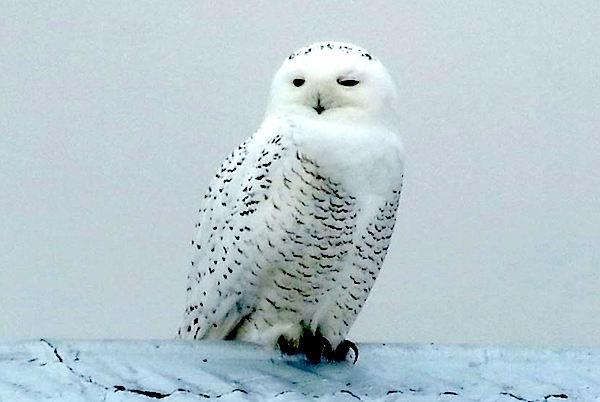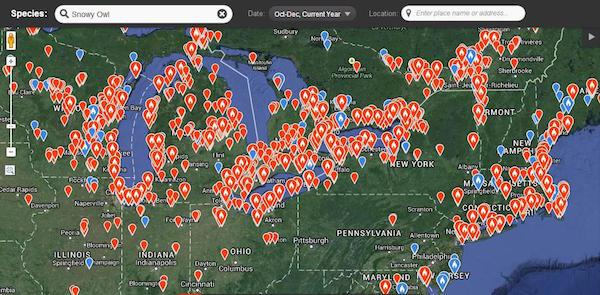
Snowy Owls are descending yet again on the United States from Canada, defying typical patterns/Kirby Adams
During an irruption of Snowy Owls back in the winter of 2011-12, I explained in this blog how it was an event that could be expected only every four to five years. I also pointed out that that winter's explosion of snowies was unusually robust and not to be missed, being a once-in-a-birder's-lifetime event.
I was technically correct on all counts, given the historical data up to that point. In light of the following winters since that time, however, I'm looking neither very informed nor prophetic.
The winter of 2012-13 was a normal 'off' year for Snowy Owls with few being reported south of Canada. That was followed last winter by an unprecedented second irruption in three years. The 2013-14 invasion was broader in scope and even more extreme than the 2011-12 episode, with the East Coast seeing a particularly high number of owls, even as far south as Bermuda.
So, lightning had struck twice. Then a couple months ago the reports of Snowy Owls in New York, Vermont, Michigan and elsewhere started trickling in, much earlier than even during a typical irruption year. Birders and ornithologists were hesitant to use the 'I' word so soon, but it sure looked like it was happening again. (Irruption is the term given to a periodic, but not necessarily predictable surge in the population of a bird outside of its normal seasonal range.)
Now, as birders head out for their Christmas Bird Counts, it's evident we are in the midst of a Snowy Owl irruption that, at least in the Midwest, is even stronger than the two most recent events. Two out of three winters was crazy, but three out of four is almost unbelievable.
The owls have brought with them mostly good news and good opportunities. We're increasing our knowledge of the birds' movements and behavior enormously. As last winter's irruption took hold, author and naturalist Scott Weidensaul and some colleagues launched Project SNOWstorm, an ambitious attempt to study the Snowy Owls that had ventured south. (The project's name plays on the use of four-letter 'banding codes' ornithologists and birders use for North American birds. A code usually is composed of the first two letters of each word of a bird's common name. American Robin is thus AMRO. In a neat twist, the code for Snowy Owl becomes SNOW.)

Mapping on eBird shows just how many Snowy Owls are being spotted in the United States.
Project SNOWstorm relied on funding from an IndieGoGo fundraiser as well as donations from birding clubs, ornithology programs, and even birding magazines. Thanks to all of the grassroots help, owls across the country were captured and fitted with tracking devices that allowed project team members to follow the owls and study their foraging and roosting behavior.
The fascinating data gathered during the winter was only the beginning. As this past fall's irruption began, two of last year's owls returned. Their transmitters rely on cell phone signals to transmit, so they couldn't be tracked during their summer in the arctic tundra, but as soon as they returned to 'civilization' researchers began following them again.
Those two owls certainly don't debunk the long-held idea that a vast majority of the irruptive individuals don't survive the winter, though they contribute to a growing collection of data that suggests many, perhaps most, make it back north. Snowy Owls are known to succumb to starvation, disease, and accident during their time south of the tundra, so much more research is warranted, but the return of at least two individuals is a great start.
Research aside, the owls are also providing incredible opportunities for casual birders and even backyard naturalists to see one of the world's most charismatic birds. It's impossible to say how many birding and naturalist hobbies have been launched over the last few winters thanks to these owls, but it's not an insignificant number. Visit any birding forum on Facebook from the Midwest and Northeast and you'll see all snowies all the time these days, a testament to how excited people are about the owls.
If there's one unfortunate aspect to the irruption, it's that in all of the excitement people will inevitably get too close or act inappropriately around the owls. Snowies are relatively tame and will tolerate the approach of cars and people, but only to a point. Birders looking for an even closer view or better photo do occasionally get too close for an owl's comfort, resulting in the bird being flushed. This further stresses an owl that is undoubtedly already stressed, not something anyone wants to happen.
Educating people about proper behavior around owls is the key to preventing these negative interactions. By the time you see an owl, it has likely been aware of your presence for some time. Their hearing is exceptional and you can't hide your approach. If you aren't perceived to be a threat, the owl will remain largely motionless, perhaps looking around, yawning, or even appearing to sleep. If the owl spends most of its time staring at you and/or noticeably shifting its position, you're inside its alert range. If you continue to approach or fail to back off, it's likely the bird will flush, robbing you and other birders of a chance for further observation, not to mention the stress to the owl. Although it should go without saying, if you do accidentally flush an owl, do not follow it to its next perch and attempt the process over again. Leave it in peace and view from a distance. That's what spotting scopes are for!
Finally, if you do see another birder or photographer flushing an owl, consider sharing this information with them in a friendly manner. There's no need to angrily confront people or take pictures of their behavior for public shaming. (Yes, that is happening frequently.) We're all going out to see these owls because we love the birds and it's natural to want to get close to them. Sometimes we all make mistakes. I've flushed an owl or two. It happens.
The owls are also hardier than we give them credit for. That doesn't mean it's not a bad thing when they're unnecessarily stressed, but it certainly isn't a death sentence to an owl when a photographer scares one away. Let's just educate ourselves and others and enjoy our shared interest. No one, including the owls, wins when nature enthusiasts start getting at each other's throats.
Let me know if you see a Snowy Owl in a national park this winter. And by all means, snap a photo (from a respectful distance!) and post it on the Traveler's Flickr page.



Comments
In reporting our latest blog post, about Snowy Owls in Acadia National Park, we found that 10 Snowy Owls have been reported to eBird so far this season, compared with 12 during the 2013-2014 irruption. Will be interesting to see what the numbers will look like once the season is over. Here's a link to our post, which includes list of all sightings of Snowies in Acadia dating back to 1981, as well as Snowy Owl hotspots in Acadia:
www.acadiaonmymind.com/2015/01/snowy-owls-acadia-national-park/
Updated numbers for Acadia Snowy Owls reported to eBird: New record set with 17 separate sightings as of our latest blog post, about the first Snowy in Maine to be outfitted with GPS transmitter, and to be named Orion.
http://acadiaonmymind.com/2015/03/snowy-owl-orion-acadia-national-park/